If you’re an outdoor enthusiast who gets a kick out of fishing, Maine ranks among the best places to visit. This scenic state has over 6,000 ponds and lakes that host diverse fish species like striped bass, brown trout, yellow perch, king salmon, and northern pike, the large, ruthless predator at the top of the food chain.
This article will largely focus on the northern pike. We’ll let you in on the largest specimen ever found in Maine’s waters and divulge essential details about this nearly invincible fish species, which is pretty easy to catch, despite its formidable nature. Let’s get to it!
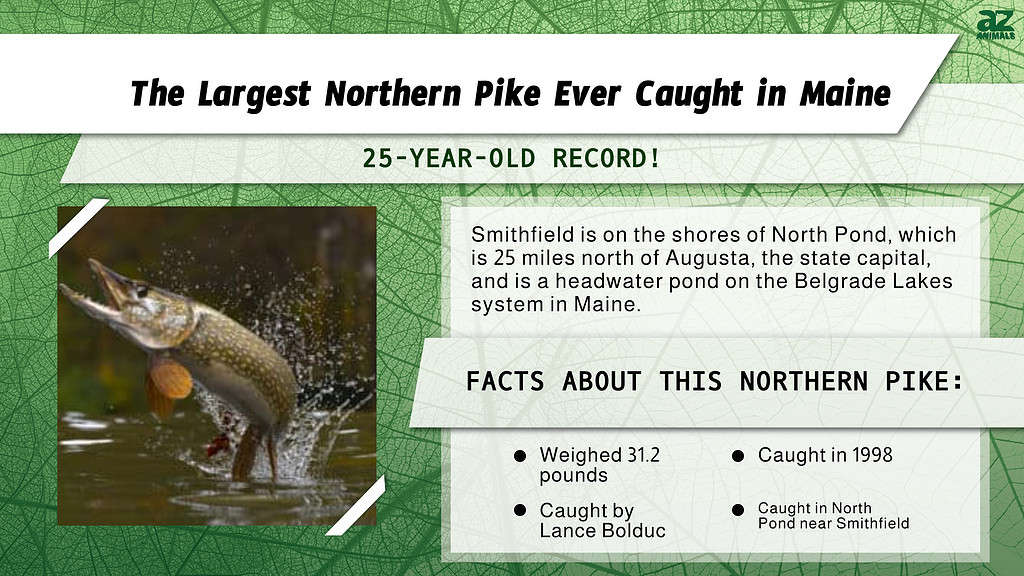
The largest northern pike ever caught in Maine was a 31.2-pound specimen Lance Bolduc caught in Smithfield’s North Pond in 1998. Other massive pikes have also been found in other parts of this state. For instance, in 2008, the enthusiastic angler Eliot Stanley caught a 41-inch northern pike weighing 17.5 pounds in the state’s second-largest lake, Sebago Lake. What was even more intriguing is that he was hunting for a landlocked salmon, which he found inside the large fish!
Unfortunately, despite being incredibly fascinating, the northern pike is an invasive species that devours pretty much anything it stumbles upon. In Maine’s Sebago Lake, the non-native was introduced illegally in 2003. By 2008, it had already threatened the existence of other fish, including the landlocked salmon, whose population had dropped significantly. Besides fish, the carnivorous northern pike eats crayfish, frogs, birds, and small mammals.
Features of a Northern Pike Fish
Here are three other crucial features to know about this fish species:
1. It’s an Excellent Hunter
The northern pike is an aggressive predator that has perfected its hunting skills; safe to say that its diverse characteristics have contributed to the latter. For instance, the fish comes with long sharp teeth to enable it to grab its prey.
Something else that prompts northern pikes to hunt is their insatiable appetites. That’s why finding one around the lake shores is common, even searching for birds. While some healthy specimens consume up to 1.5-3 times their body weight, others in waterbodies with abundant fish populations can eat up to 5 times this amount.
Furthermore, northern pikes are unmatched hunters owing to their fast speeds of up to 10 mph. It allows them to chase their prey and put up a good fight, despite their sometimes massive size and heavy weight.
As an aquatic apex predator, the northern pike is well-camouflaged, enabling it to ambush its prey. Ideally, the fish species has olive-green molten skin resembling aquatic vegetation. It allows it to hide in the latter, staying still for long as it awaits the perfect opportunity to strike without warning.
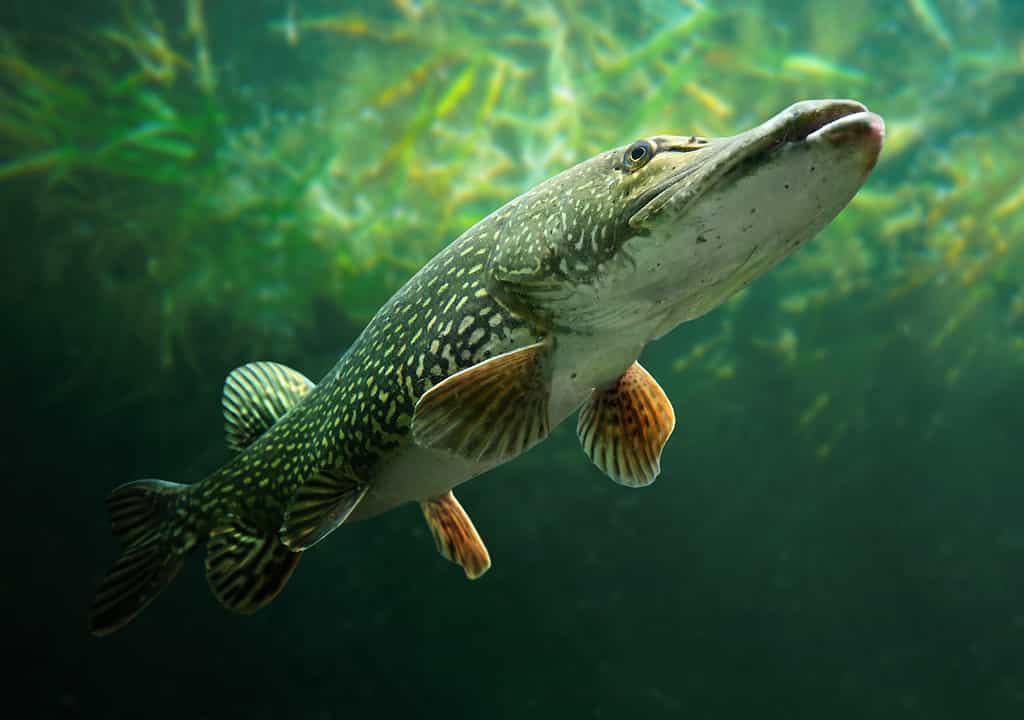
With its sharp teeth and lightning-fast strikes, the northern pike is a true force to be reckoned with in the aquatic realm.
©iStock.com/abadonian
2. It Can Live Up to 35 Years
Typically, northern pikes have a lifespan of 10-15 years. However, some specimens have defied the odds to live up to 25-35 years. The females usually live longer than the males, but the survival of both genders depends on their environments. So, a northern pike’s lifespan increases as you go north. Specimen in these areas also grow slower than those in the southern range.
3. It’s a Solitary Species
Even with its penchant for hunting, the northern pike prefers spending time alone. It only swims up to 500 meters unless it’s searching for food or spawning. The species also make an exception to help younger fish hone their hunting skills or avoid predators. Speaking of which, some of the animals that prey upon them are:
- Otters
- Dogs
- Bears
- Waterfowl
- Humans
Sea lampreys, or the “vampire fish,” also munch on northern pikes in the Northern Hemisphere. The parasitic species usually attach themselves to the fish, rupturing its skin to drain its fluids and kill it. Other options it enjoys feeding on in the water are salmon, lake trout, walleye, lake sturgeon, and burbot.

With its solitary lifestyle, the northern pike demonstrates strength and resilience.
©Rostislav Stefanek/Shutterstock.com
Can You Eat Northern Pikes in Maine?
Despite being invasive and aggressive species, northern pikes are safe for consumption. They’re rich in protein and vital nutrients like vitamin D, selenium, and niacin. As of this writing, over 30 water bodies in Maine are home to decent northern pike populations. If you’d like to enjoy their health benefits, consider visiting Maine. These tips can help you enjoy the best angling experience and catch one or more species:
1. Get the Right Angling Equipment
The first step to preparing to catch the northern pike in Maine is to gear up. Your kit should have these essential items:
A Quality Reel
The right reel increases your chances of catching the northern pike in Maine waters. We propose investing in one whose maximum drag is at least 25 pounds, but one with a drag of 15 pounds will also work, though you might not necessarily hook the largest specimen.
Quality Fishing Line
If you’re a northern pike fisher in the Pine Tree State, you should invest in quality fishing lines, depending on your reel. Therefore, if your reel comes with about fifteen pounds of drag, a 15 or 20-pound braided line is ideal. A thirty or forty-pound braided line is convenient when leveraging a reel with a 25-pound drag.
Remember that the northern pike boasts unbelievably sharp teeth that often bite through the lines. Therefore, it’s advisable that you only choose the best brands to land quality options.
Consider adding a wire bite to your fishing line’s end to prevent the pike from biting off — remember that it may affect your lure choice.
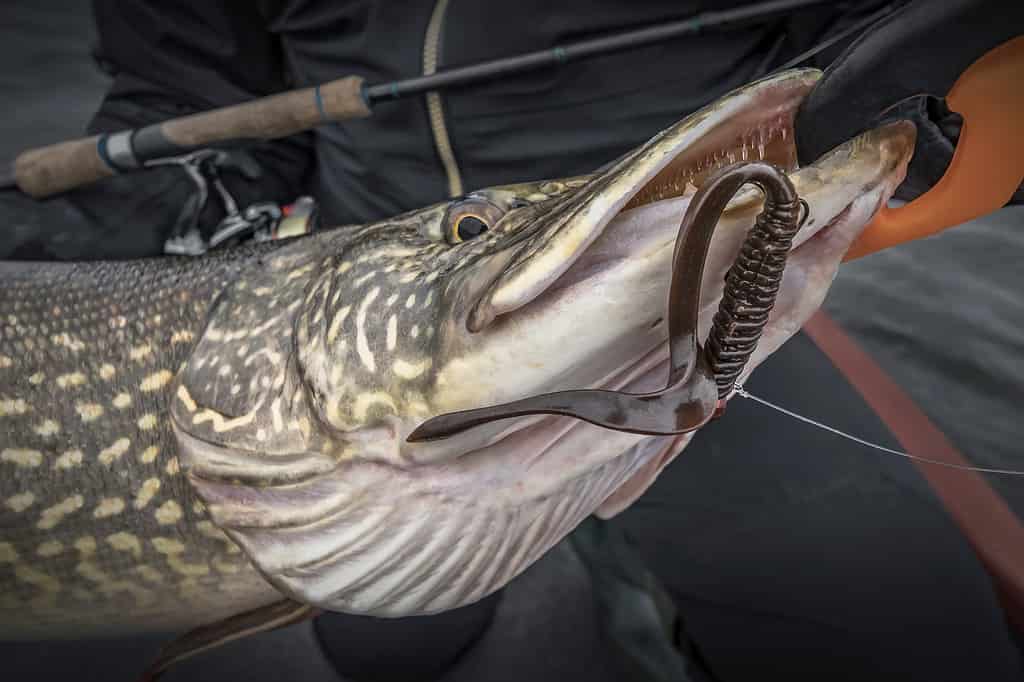
The right angling equipment is the key to unlocking the true essence of the fishing journey.
©iStock.com/FedBul
Strong Lures
Lures are also handy in northern pike fishing as they attract the species to boost your chances of catching them. So, some of your best options are spoons. Make sure to allow them to flutter and fall so the nearby hungry pike can mistake them for injured fish.
Plastic swim-baits also make excellent lures when targeting the northern pike. Thankfully, they’re easily customizable, depending on the fishing location. Nevertheless, remember that they come in many sizes, colors, and styles.
When hunting for the northern pike, it’s prudent to research the type of fish inhabiting the waterbody you plan to explore. Then, match your lures to the species to attract the latter’s attention. Also, remember that pike are sight feeders, so your options should be bright colors like orange and white.
A Strong Rod
A rod is another essential for northern pike fishing enthusiasts in Maine. Some anglers opt for standard seven-foot, medium-heavy sticks, but you must consider your bait before making your pick. For instance, if you aim to hook a larger, heavier pike, you want a strong-enough rod to handle all the action.
Long Pliers
As experienced pike anglers can attest, long, needle-nose pliers are also useful when casting. It enables you to remove the hook for the fish, which might not be easy for amateurs or if you catch large, weighty fish.
Furthermore, don’t throw caution out the window when detaching the pike from the hook. The species serrated gills and sharp teeth can easily cut through your skin while at it.
2. Pick the Right Location
Ideally, Maine offers over thirty water bodies with the northern pike. Which are the best picks for anglers? Answering this question before planning and embarking on your angling trip is critical as it helps you plan appropriately. Lakes in central Maine are known to produce the largest pike. These include:
- Great Pond
- Long Pond
- East Pond
- Annabessacook Lake
- Salmon Lake
- Messalonskee Lake
- McGrath Pond
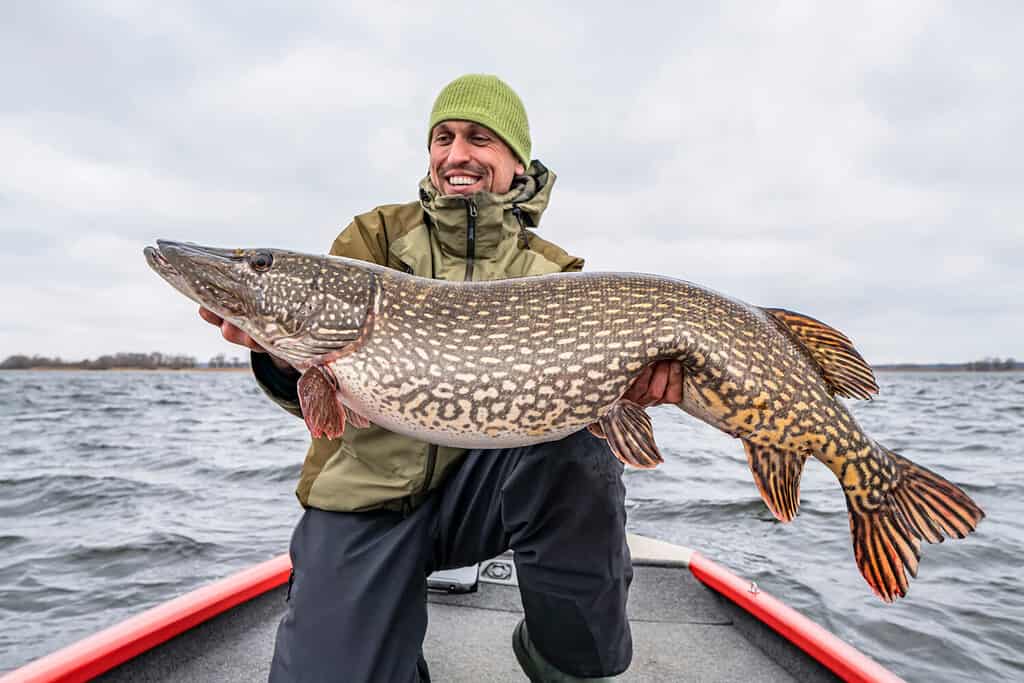
Choosing the perfect fishing location is paramount when targeting northern pike.
©FedBul/Shutterstock.com
3. Know When to Go Pike Fishing
Mastering seasonal change is a good way to maximize your chances of finding sizeable pike. Here’s a breakdown of what to expect when going pike fishing in fall, summer, spring, and winter.
Going Pike Fishing in Fall
Typically, the temperatures cool in the fall, causing aquatic vegetation to die gradually; this makes it harder for the northern pike to spot smaller types of bait fish, meaning they’re less likely to hunt as much during the season.
Nevertheless, that doesn’t mean you catch pike in the fall. Look for patches receiving direct sunlight, as vegetation is less likely to dry up. Leveraging a fish finder to locate areas with fish activity near rocks, ledges, and algae is also a great idea.
Moreover, if you see bait fish in the shallow regions of water bodies that host the pike, there’s a high chance you find some live specimens in the area.
Going Pike Fishing in Summer
Summer is also an ideal time to go pike fishing in Maine if you know where to look. The high temperatures force the fish to move to deeper waters to stay cool, so you should explore regions with lower temperatures. These are usually near deep basins and rocky points, where they’re also likely to find bait fish.
Pike Fishing in Spring
Should you plan your pike fishing trip in the spring, opt for bays that warm quickly. The species’ feeding activity usually soars between 55 and 60 degrees Fahrenheit. Maine waters are typically full of life by mid-spring, allowing you to find the northern pike in their usual habitats. Besides, the aquatic vegetation is also healthy, so look near them to catch the fish.
Pike Fishing During Winter
Ice fishing for the northern pike is enjoyable for most anglers. Most waters are jam-packed with the species, meaning you can easily catch one without throwing in many lines. Find the fish in the lake or pond you visit to identify the best spots.
For example, if the body of water you’re fishing in has plenty of whitefish cast in the open areas. That’s where northern pike are likely to flock to for food.
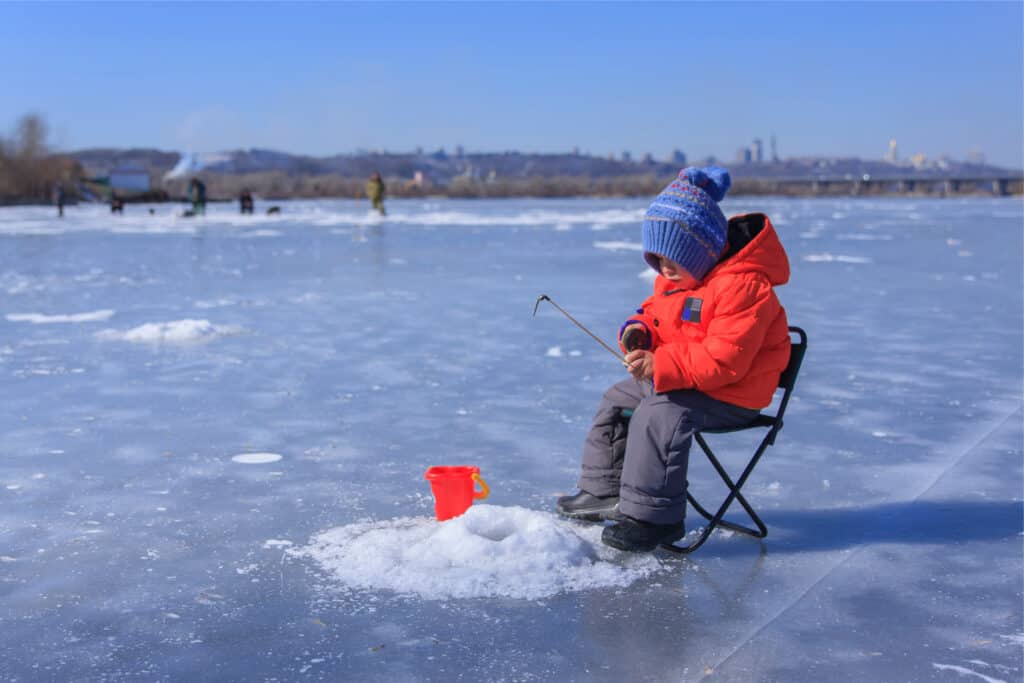
Embrace the magic of winter fishing as you venture onto frozen lakes in pursuit of northern pike.
©kadetfoto/Shutterstock.com
4. Choose the Right Time of Day
As with any other activity, timing is everything when fishing for northern pike in Maine waters. We recommend doing it early morning or mid-morning and evenings when the species are most active. You can still catch plenty at midday or late afternoon but not at night. As mentioned earlier, northern pike are sight feeders and will barely bite at night.
Other Types of Fish in Maine Waters
As you hunt for northern pike in Maine waters, you might be lucky to catch other popular fish species in the state. These include:
Cusk
The cusk is a representative of the family Lotidae. It boasts a slender profile with a single, long, thick dorsal. While all species’ pectoral fins are edged in black, they come with varying colors ranging from yellow to green-brown to red-brown.
Cusks mainly stay in sea bottoms because they’re lazy and unskilled swimmers. Although they’re known to occupy freshwater bodies in Maine, they’ve only been confirmed in about 8% of tested lakes. Most of them cover less than a hundred acres and are located in the northeast and Downeast parts of the state.
Herrings
Did you know there are nearly 2000 herring species? These fish belong to the family Clupeidae and mainly occupy shallow waters in Maine. Most adult specimens measure between 8 and 15 inches and like moving in large groups.
Herring fish feed on planktonic crustaceans like copepods and pteropods. On the other hand, larger predatory species like salmon, tuna, sharks, cod, and striped bass prey on them. Northern pike also fancy them, so you can use them as bait when fishing for the invasive species.
The American shad and blueback herring are common in Maine lakes and rivers.
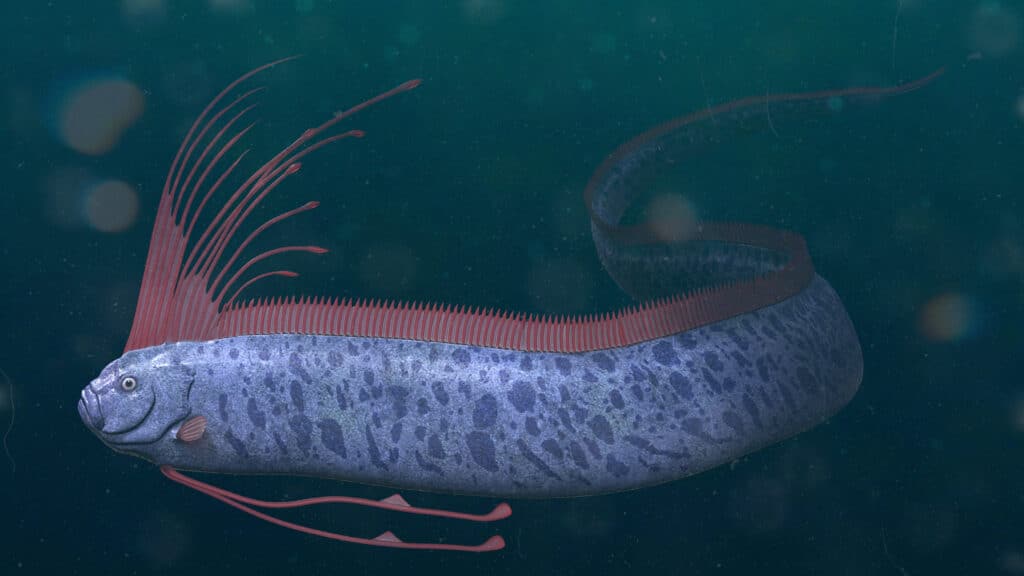
The vibrant herring is a species known for its stunning silver hues and synchronized swimming patterns.
©Dotted Yeti/Shutterstock.com
Brook Trout
Another dominating type of fish in Maine waters is the brook trout. The species has been found in up to 69% of the state’s lakes and rivers, no matter their sides or elevation. The large population is mainly maintained by stocking by the Maine Fish and Wildlife Conservation Office.
Most brook trout you’ll likely catch in Maine measure 9-10 inches long, though some are up to 12 inches long. The fish are wider in the middle and have dark, olive-green backs with distinct pale, worm-like patches.
Brook trout’s diet is diverse as it feeds on small animals like insects, salamanders, tadpoles, small water snakes, and fish. In turn, opportunistic larger fish like pike and birds – including vultures and ospreys – prey on it.
American Eel
The nonvenomous American eel is North America’s only catadromous fish. That means the species, recorded in at least 32% of Maine’s surveyed lakes, often move down rivers to breed on oceans.
American eels are known for their long snail-like bodies that set them apart from other fish. Their thick skins boast a heavy slime layer that come in multiple colors; their backs are olive green to brown, while their sides are yellow-green.
Sexually mature American eels leave freshwaters to head to the ocean for spawning, a period that sees them change to “silver eels” with silver undersides.
A Memorable Pike Fishing Experience Awaits You in Maine
Maine is a paradise for anyone who relishes angling. Some of the world’s largest fish, including lake trout and northern pike, have been caught in this northeastern state. The latter is particularly hunted for its white, flaky meat with a tasty flavor of vitamin D, niacin, protein, and B-12.
Maine’s waters also host numerous small fish species, such as shad, black crappie, smallmouth bass, and yellow perch. If you miss the northern pike during your angling trip, you’ll likely land any of them.
Angling in the Pine Tree State enables you to interact with nature, bringing many perks, such as boosting your mental health and taking your creativity to the next level. Happy fishing!
What’s the Largest Pike Ever Caught?

The largest pike on record to have ever been caught was not in Maine, but instead, in the Chippewa Flowage at Hayward in Wisconsin. This Guinness Book of World Records fish was caught by Louis Spray on July 24, 1949. It weighed 67.48 pounds and was 5.29 feet long.
This particular species of pike was the muskellunge, also referred to as a muskie or musky. The name muskellunge is thought to come from the word “maashkinoozhe” which translates to “ugly pike” in the Ojibwa language.
The photo featured at the top of this post is © bekirevren/Shutterstock.com
Thank you for reading! Have some feedback for us? Contact the AZ Animals editorial team.







